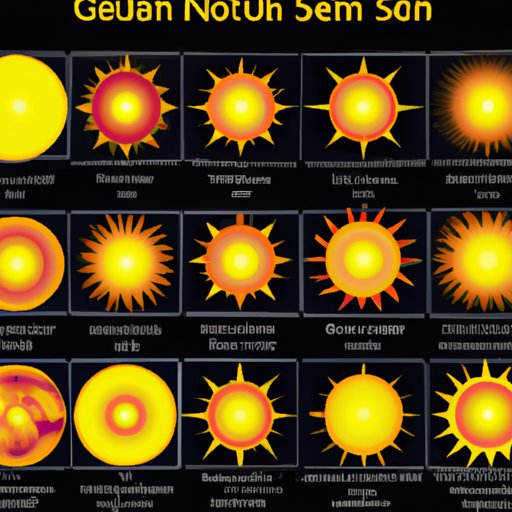Introduction
Stellar classification is the process of categorizing stars based on their physical characteristics, and it is essential in understanding the universe we live in. Knowing the type of star the Sun is, for instance, not only helps us understand our place in the cosmos, but it also allows us to study and compare our star with others. In this article, we will explore what kind of star the Sun is and its vital role in the universe.
What Kind of Star is the Sun: An Introduction to Stellar Classification
There are many different types of stars, each with unique physical characteristics and chemical compositions. Stars are classified based on various criteria such as their size, temperature, luminosity, and spectral type. One common method astronomers use to classify stars is the Hertzsprung-Russell (H-R) diagram.
The H-R diagram is a graph that plots a star’s luminosity against its temperature. The diagram is useful in displaying the relationship between the various types of stars and their evolutionary paths.
The Sun: A G-Type Main Sequence Star and Its Characteristics
The Sun, as we know it, is a G-type main sequence star. G-type stars are yellow stars that are smaller and less luminous than some other types of stars, such as A and B-type stars. The Sun has a mass of around 1.989 x 10^30 kilograms and a diameter of about 1.39 million kilometers.
The Sun’s surface temperature is about 5,500 degrees Celsius, and it has an estimated age of about 4.6 billion years. The Sun rotates on its axis once every 27.3 days, and it has a powerful magnetic field, which is responsible for phenomena such as sunspots and solar flares.
Exploring the Sun’s Spectral Type and Its Importance in Astronomy
Spectral types are another way astronomers categorize stars. Spectral type is determined by the star’s temperature and chemical composition. The Sun has a spectral type of G2V.
The “G” in the Sun’s spectral classification means it is a yellow star, while the “2” indicates it is a moderately hot G-type star. The “V” tells us that the Sun is a main sequence star, meaning it is still fusing hydrogen into helium in its core and has not yet evolved into a giant or a supergiant star.
Studying the spectral types of stars is essential in astronomy. Spectral analysis can reveal a star’s physical properties such as temperature, luminosity, and chemical composition.
A Comparative Study of the Sun and Other Stars in Its Class
While the Sun is unique, it is not alone in its classification as a G-type star. Many other stars have similar physical characteristics to the Sun, and studying these stars can help us better understand our star.
Some stars that are similar to the Sun include Alpha Centauri A, Tau Ceti, and 18 Scorpii. By observing and studying these stars, astronomers can gain insight into the Sun’s behavior and evolution.
One example of this is studying the Sun’s magnetic field. By comparing the magnetic fields of other G-type stars to the Sun’s magnetic field, astronomers can learn more about the long-term behavior of the Sun’s magnetic field and its effect on the Earth.
Unraveling the Mystery Behind the Sun’s Nuclear Fusion and Its Role in Life on Earth
The Sun’s energy comes from nuclear fusion, a process where hydrogen atoms in the Sun’s core combine to form helium. In this process, enormous amounts of energy are released in the form of light and heat.
Nuclear fusion is vital to life on Earth. The energy from the Sun fuels the growth of plants, providing us with food and oxygen. The Sun’s energy also powers the water cycle, drives weather patterns, and is the primary source of energy for all life on the planet.
The Sun’s Evolutionary Path: From Protostar to Main Sequence Star
The Sun, like all stars, began its life as a cloud of gas and dust called a nebula. Gravity caused the nebula to contract and heat up, eventually forming a protostar at its center. As the protostar continued to gather material, its core became hot and dense enough to initiate nuclear fusion, and it became a main sequence star like the Sun we know today.
Over time, the Sun will continue to evolve. After about another five billion years, it will exhaust its hydrogen fuel and begin to fuse helium in its core. This process will cause the Sun to expand and cool, eventually becoming a red giant. The outer layers of the red giant will eventually be expelled, leaving behind a small, hot white dwarf.
Conclusion
The Sun, our G-type main sequence star, plays a crucial role in the universe and life on Earth. Understanding the physical characteristics and behavior of the Sun helps us better understand our place in the cosmos and can provide vital insights into other stars and planetary systems. Through stellar classification and continued study, astronomers continue to unlock the mysteries of the universe.
